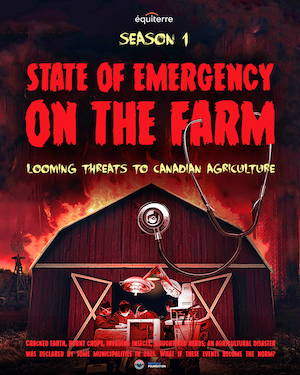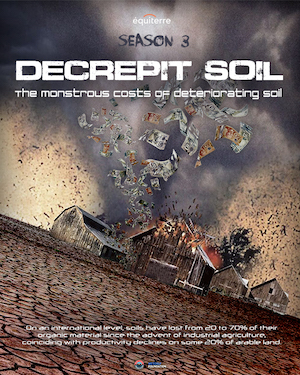Published on
Reeling from the effects of climate change, Canadian agriculture is facing a multitude of challenges. Extreme weather events, devastating crop and livestock losses, soil deterioration and declining farm yields are sounding the alarm, emphasizing the need for innovative agriculture practices, programs and policy.
Season 1: STATE OF EMERGENCY ON THE FARM
Looming threats to Canadian agriculture
Cracked earth, burnt crops, invading insects, slaughtered herds; an agricultural disaster was declared by some municipalities in 2021. What if these events become the norm?

Fact
Though rising temperatures could benefit certain crops, severe climate events are posing major economic challenges to agricultural enterprises:
- loss of productivity;
- higher production costs (in some cases, much higher);
- increased costs of raw materials and agricultural and food commodities;
Our food system as a whole could be at risk.
Solutions
We must encourage agricultural practices that help improve soil health, in order to:
- increase carbon sequestration by the soil, in turn enriching soil organic matter and reducing greenhouse gas (GHG) emissions.
At the end of the day, these practices will help ensure long-term agricultural productivity and resilience:
- improving farm revenues, improving food security, stabilizing hydrological cycles, enhancing human health and preserving biodiversity.
Season 2: MISSING WITHOUT A TRACE: QUEBEC BLUEBERRIES
Our pantries are in peril
The worst year in a decade for the Quebec blueberry harvest, producers lost up to 90% of their harvest and claimed $5.3 million in damages in 2021. An early spring, late freeze and summer drought; too many blueberries were reported missing.

fact
Compensation paid for crop losses, all crop types combined, increased 10-fold from 2015 to 2019, reaching a total of $138 million in 2019. That year, grain producers submitted compensation claims for losses caused by a late spring and an early winter. Agricultural risk management programs have been able to cover the damages in recent years, but what happens if these conditions persist year after year?
Solutions
Emergency measures aren’t enough. Governments must adopt policies to help farms adapt to the long-term impacts of climate change. Solutions must foster soil conservation and regeneration practices, such as crop rotation, cover crops, soil compaction prevention and integrated anti-parasite measures.
Season 3: DECREPIT SOIL
The monstrous costs of deteriorating soil
On an international level, soils have lost from 20 to 70% of their organic material since the advent of industrial agriculture, coinciding with productivity declines on some 20% of arable land.

fact
In Canada, poor soil health is costly for everyone. Soil degradation represents 40 to 60 billion dollars in lost GDP since the 1970s. Beyond the decline in organic material, extreme weather conditions and resistance to pesticides are causing increasing yield losses. Based on these impacts, the United Nations Food and Agriculture Organization has predicted that the world may have only 60 harvests left.
Solutions
Agricultural and climate policies must be put in place to help more farmers make soil health a priority, via a systemic approach that considers each farm’s regional climate and soil characteristics. Support must be provided for research, awareness efforts, knowledge transfer, knowledge sharing among farmers, technology and better financial incentives.
To learn more about the importance of soil health in agriculture, and to act:
- Join us for an upcoming webinar: Climate change and agriculture: stories from the field – on November 10th at 1:30 pm:
https://www.facebook.com/events/925276334746993
The webinar will bring together farmers from different regions, who will share their personal experiences about how climate change is impacting their farms, followed by a discussion on possible solutions for adapting to climate impacts and becoming more resilient.
- Have a look at a past webinar: Healthy soils? What it is and Why it matters, presented by the Greenbelt Foundation: https://youtu.be/O8bNZ40E7HQ
- Learn more about soil health





